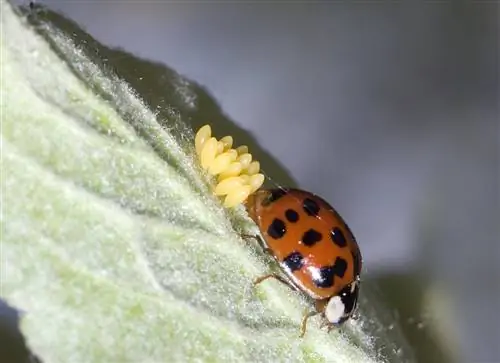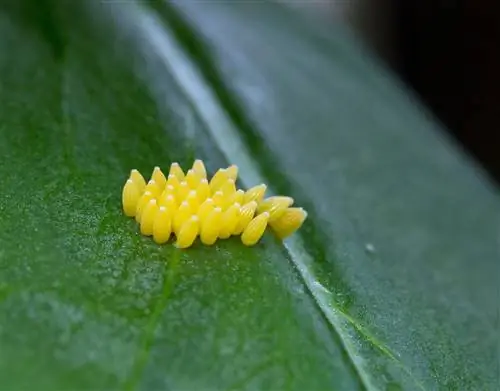- Author admin [email protected].
- Public 2023-12-25 17:45.
- Last modified 2025-01-23 11:22.
Are you wondering what those little carpets of balls are that stick neatly under the sides of leaves and on tree trunks in spring? Don't remove them, because very useful, pretty and friendly garden helpers develop here: ladybirds!

What do ladybug eggs look like and where can they be found?
Ladybird eggs are elongated, light yellow and between 0.5 and 2 mm in size. They are laid in groups of 10-60 eggs on the undersides of leaves and tree bark to give the larvae immediate access to food such as aphids or scale insects.
The development cycle of ladybugs
Ladybirds form their own, very genus- and species-rich family within the order of beetles. There are around 250 genera and 6,000 species worldwide, of which only a few hundred occur here. How ladybugs live and maintain their species is not much different from the cycles of other beetles. With the exception of one special feature: If they want and the conditions are favorable, they can survive not just one, but even two winters!
A ladybug goes through the usual stages of development:
1. Egg
2. Larva
3. Doll4. Imago (adult beetle)
Preparing the eggs
The ladybird year begins early, in late winter. Immediately after waking up from hibernation, they look for partners to mate with. A mated female then begins laying eggs at the end of April. In total it can lay up to 400 eggs, but this varies depending on the species. The female ladybird divides this impressive number of eggs into small groups, which she lays in a close and fairly neat row in suitable places. A clutch usually has 10 to 60 eggs. Some species also lay their eggs individually.
Where to find the eggs
The female looks for suitable food sources in the depositing areas, which should be immediately available to the hatching larvae for self-service. The egg groups can often be discovered especially on the undersides of leaves and in cracks in tree bark.
Suitable food for the larvae is - and this is what determines their status as a beneficial garden insect - primarily aphids. The larvae of scale insects also become large and strong. Where many of these plant sap suckers are found, ladybirds will also prefer to send their larvae into life. Twenty-two-spot ladybugs also conveniently feed on mildew fungi.
What ladybug eggs look like
Ladybird eggs have relatively different appearances depending on the species. Most are elongated in shape and light yellow in color. But some are also rounder and have a more orange or whitish tone. The size varies between half a millimeter and two millimeters.
The development of the larva in the egg
Depending on the temperature and humidity, it takes 5 to 8 days for a ladybird larva to grow in an egg. Towards the end of the development period, the larva can be recognized through the thin egg membrane. The egg then turns greyish in color. It takes a ladybird larva about 2 hours to emerge from the egg. To open, many species have impact tools in the head, back and chest area, which are thrown off after single use during the first molt.






